|

The uniforms of the Saxon army were most likely very typical for European
armies of this age but unfortunately not much is known about them. The
information I have about their infantry (and artillery)
uniforms is presented on this page (the cavalry has a
separate page). The main sources to this information are two
publications that are not entirely consistent with each other: Daniel Schorr's article "Notes
on the Saxon Army 1700-1716" (previously published on his now
defunct website www.northernwars.com),
and Lars-Eric Höglund's book "Stora nordiska kriget 1700-1721, III".
General Uniform Information
| |
Privates |
Drummers |
Officers & NCOs |
|
Hat: |
Black felt hat with the brim folded up in
different ways. The tricorne hat spread slowly and probably did not
become standard until at least 1707. According to Daniel Schorr, the hat
lace would correspond to the button colour (brass = yellow, pewter =
white), but Höglund also states other colours. A white cockade was
possibly on the left side of the hat. |
Officers probably had gold or silver lace while
NCOs may have had silver lace. Regimental officers may also have had
white feathers on their hats. |
|
Neckcloth: |
It was probably standard to have both a white and
black neckcloth but some regiments had red ones. After 1707, the
neckcloth was tied behind the neck instead of having a cravat as before. |
|
Coat: |
Red coat 1695-1733 (then white) At first the
buttons covered the entire length of the coat, but around 1707 this was
changed so that they only went to the waist. Horizontal pocket flaps
with three buttons. Possibly a shoulder strap on the left side for the
cartridge box belt.
Facings and lining in the regimental colour. The
cuffs had three buttons each. |
The drummers may have had lace on their sleeves (probably
in the button colour) and a collar in the regimental colour. Sometime
after 1707, the lace on the sleeves disappeared and were replaced with
red swallow's nests edged with the regimental colour on the shoulders. |
Officers: Probably gold or silver buttons.
NCOs: May have had a collar and silver lace on the
cuffs. |
|
Kamisol (Vest): |
Red vest, but it could also be in the regimental
colour. Similar to the coat, it had buttons along the entire length of
the vest, however these were of a smaller size. After 1707 the vest may
have had a collar worn over the coat. Höglund consistently states that
the vest was in the regimental colour. My images follow Höglund unless
Schorr explicitly states that the regiment had a red vest. |
|
Breeches: |
Usually leather but some regiments had cloth
breeches. |
The officers of Wostromirsky had red cloth
breeches and probably the officers of the other regiments also had cloth
breeches. |
|
Stockings: |
Usually grey-white or white stockings. Some
regiments, however, had stockings in the regimental colour. |
|
Shoes: |
Black shoes with brass buckle. |
|
Belts and gauntlets: |
Buff leather. |
Officers' waist belts may have been covered with
material in the regimental colour and trimmed with gold or silver. |
|
Sword and scabbard: |
Sword hilt made of white metal and scabbard of
dark brown leather. |
|
Specific equipment: |
Flintlock muskets, socket bayonets and swords.
matchlock muskets and plug bayonets were, however, still in use in some
regiments at the beginning of the war. Cartridge box and grenadier box in brown or black leather. Cartridge box
belt made of buff leather with a priming horn attached to it.
The second and third ranks of the battalion also carried boar spear ("swine
feathers"), which were used to create chevaux de frise as protection
against cavalry. |
Wooden drums painted red with
descending flames in the regimental colour so that triangle patterns are
formed. The top and bottom edges painted in alternating vertical or
diagonal stripes in red and in the regimental colour.
In addition to this, the drum also had the coat of arms of Augustus the
Strong (the coat of arms of Saxony plus the coat of arms of
Poland-Lithuania) on a white background.
|
NCOs had halberds. Officers had spontoons with
a design that varied in the different regiments.
The gorget as a distinction for officers was
introduced in 1715 and was of silver with the royal cypher in gold (the
letters FA under a crown).
The sash was also officially introduced for officers in 1715 but had
probably been worn earlier although the colours before then are unknown.
In 1715 it would have the colours silver and crimson. It was usually worn
over the shoulder but it is possible that it was also worn around the
waist. |
|
|
Grenadier Cap
|
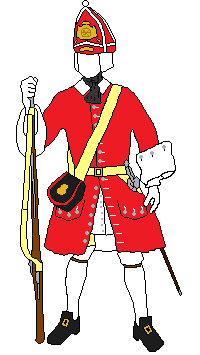
Saxon Guard Grenadier |
|
Front: |
The front plate was usually of stiff red cloth
edged with the regimental or button colour. The edge could be straight
or scalloped. If there was a front flap, it was normally in the
regimental colour or red. It too was edged.
A plate of brass or pewter with the coat of arms
of Saxony was normally attached to the front. There could also be a
number of grenades, also made of brass or pewter. The front also had a
metal emblem with the regimental name, either brass or pewter (one
regiment, Kurprinz, had copper). |
|
Back: |
The rear flap
could be red or in the regimental colour, also trimmed with the
regimental or button colour |
|
Bag: |
Either a hanging bag or a bag attached to the
front plate so that the cap looked like a mitre. It was either red or in
the regimental colour and trimmed in the button or regimental colour.
The tuft was normally in the button colour. |
As the army was reorganised in 1707, 1716-1717 and 1730-1733 and new
uniforms were issued in large numbers, these dates may be times when the
uniforms underwent major changes.
Also of interest is information from Rehnsköld in 1704 that Augustus the
Strong had made uniforms "in the Swedish manner " in that Saxons are
said to have appeared with blue coats with small cuffs and white lace on
their hats (Bellander p. 224). One Saxon dragoon regiment (DR 9) is reported
to have had blue coats replaced with red in 1704 but maybe there were more.
|
|
Polish Guard
(Polnische Garde and
from 1712:
1.
Gardesregiment) |
Saxon Guard
(Sächsische Garde and
from 1712:
2. Gardesregiment) |
|
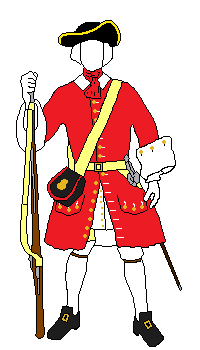
1701
White facings, brass buttons |
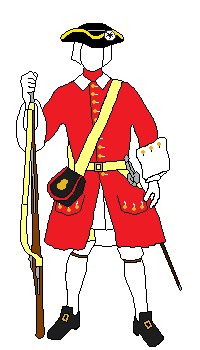
1707 |
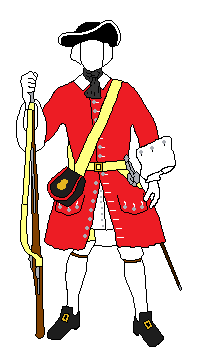
1701
White facings, white vest, pewter buttons,
black neckcloth. |
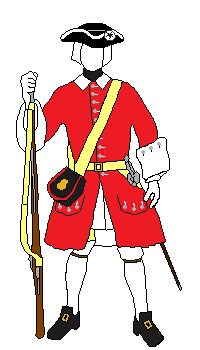
1707 |
The
Guard regiments, which were temporarily merged in about 1706 ("
Doppelregiment Garde "), may have had collars on their coats as a sign
of their higher rank, according to Schorr. Both Guards regiments had
cartridge boxes of black leather edged with a red cord on the flap and a
round badge of brass with the coat of arms of Saxony and a crown. The
Guard regiments' grenadier boxes had instead of the emblem the royal
name cypher in brass (the letters FAR under a crown).
According
to Schorr, there is conflicting information about the neckcloth colour. One
source (Kuhn) states that both regiments had red neckcloths while another
(Dietrich) states that they had white neckcloths. Dietrich also depicts the
Saxon Guard with yellow facings, but this is likely a later uniform. Schorr
considers it likely that the regiments had several neckcloths of different
colors and mentions that the Saxon Guard had black neckcloths.
Schorr
also mentions an illustration which probably depicts a grenadier officer in
a Guard regiment around 1716. He has a tricorne hat with silver lace, white
feathers and a white cockade on the left side. The right shoulder has an
aiguillette in white/silver. The waist belt and cartridge box belt are
trimmed with silver lace. The cartridge box is of buff leather with the flap
trimmed with silver and fitted with a silver plaque with a crown. The
officer wears a black neckcloth and is armed with a flintlock musket.
Höglund
states that both Guard regiments had white wests, red hat lace and
buttonholes embroidered in white. However, the button colors he states are
incorrect as he has admitted to me that he mixed up the regiments.
Both Guard regiments had in 1700 white colours
with decoration matching the button color (brass buttons = gold
decoration and pewter buttons = silver decoration). In 1701, they were
replaced with colours that had the coat of arms of Poland and a red
border as decoration. Six new white colours were made for the Guard in
1706 but were not issued until after the Swedish army left Saxony. In
1715, another 15 new white colours were issued.
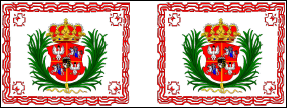
Polish Guard m/1701 |
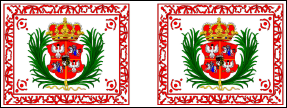
Saxon Guard m/1701 |
Düna 1701,
Kliszow 1702, Thorn 1703, Posen 1704, Punitz 1704, Fraustadt 1706. a
battalion each in the service of the Maritime Powers 1707-1713.
Malplaquet in 1709, the Saxon Guard took part in the siege of Tönning
in 1713. |
|
Kurprinz
|
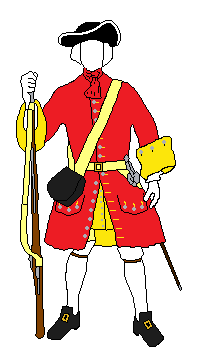
1701 |
Facings and vest lemon yellow (a 1715 source
describes the colour as "sulphur yellow"). Red neckcloth and pewter
buttons. The grenadier caps had a copper plate with the regimental name
on the front.
Höglund adds that the hats had white brims and
that the scarves were white. The latter does not necessarily contradict
the statement of red scarves as they may have had several.
Lemon yellow colours with silver decorations in
1700.
Raised in 1680.
Changed its name to "Crown Prince" in 1713 according to Höglund.
According to Schorr it changed its name to "Königl. Prinz" in 1717.
Düna 1701, Kliszow 1702, in the emperor's
service November 1702 to May 1704, Posen 1704, Punitz 1704, Fraustadt 1706,
A battalion in the Maritime Powers' service 1707-1713, Malplaquet 1709, Stralsund 1715, Stresow 1715. |
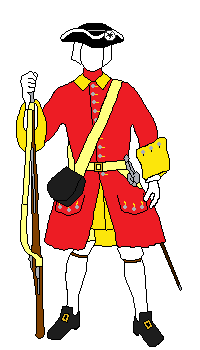
1707 & 1715 |
|
|
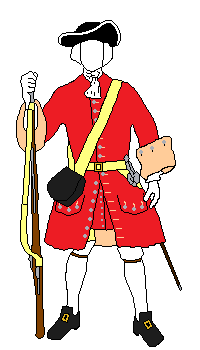
1701 |
Königin
("Queen's Regiment")
According to Höglund the facings were "isabel coloured" while Schorr notes that the colour was "dark Straw". Although I
interpret these colour names as referring to the same shade. Harder to
reconcile are on the other hand the following information:
Höglund: Isabel coloured vest, brass buttons.
Schorr: Red vest, pewter buttons.
However, both agree that the neckcloths were white and Höglund states
that the hats had white lace. Isabell
coloured colours with gold decorations in 1700. Two new coloures
were made for the regiment in 1706 which were pale yellow (paille). Raised in 1682. |
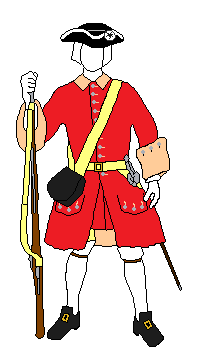
1707 & 1715 |
Düna 1701, Kliszow 1702,
in the emperor's service November 1702 to May 1704, Posen 1704, Punitz 1704,
Fraustadt 1706, a battalion in the Maritime Powers' service 1707-1713, Stralsund 1715, Stresow 1715. |
|
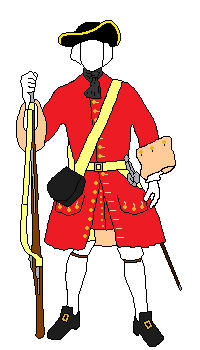
1701 |
Benkendorf
(1700-1701)
Egidy
(1701-1702)
The regimental colour was the same as for Königin, which Höglund calls "isabel" and Schorr
calls "dark straw" even though these probably are the same
shade. Both agree that the regiment had brass buttons but here too Höglund notes that the vest was in isabel while Schorr writes that it
was red. Schorr also mentions that the neckcloths were red.
Red
colours with green "rautenkranz" and gold decorations in 1700.
Existed 1675-1702. The men were transferred to Steinau's regiment. |
|
|
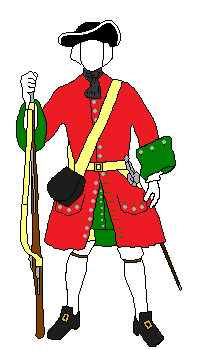
1701 |
Röbel
(1701)
Steinau
(1701-1702)
Facings and vest green, pewter buttons and a black neckcloth. Schorr
notes that they also white neckcloths and Höglund mentions that the hats had
black lace.
Green
colours with silver decorations in 1700 .
Existed 1682-1702. Disbanded after severe casualties in the Battle of
Kliszow 1702, the men were possibly transferred to Fürstenberg's
regiment.
Kliszow 1702
|
|
|
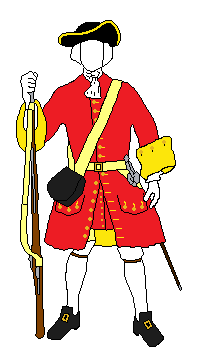
1701 |
Tiesenhausen
(1700-1701)
Thielau
(1702-1705)
Lemon yellow facings and brass buttons. The vest was red according to Schorr
but lemon yellow according to Höglund. Schorr states that the neckcloth
was black and Höglund writes that the hat had black lace.
Pale yellow colours with silver decorations in 1700.
Existed 1692-1705. The men were transferred to
Sachsiska gardet..
Düna 1701, Kliszow 1702,
in the emperor's service November 1702 to May 1704, Posen 1704, Punitz 1704.
|
|
|
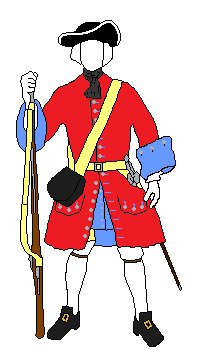
1701 |
Neitschütz
(1700-1701)
Pistoris
(1701-1702)
von der Goltz
(1702-1705)
Facings and vest in bleumerant (pale blue) as well as pewter buttons and according to Schorr a black neckcloth.
Light blue colours in 1701.
Existed 1692-1705
Kliszow 1702, Thorn 1703.
|
|
|
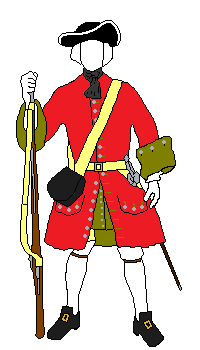
1701 |
Sacken
Moss green facings and pewter buttons. Höglund notes that the vest was
moss green while Schorr mentions that the neckcloth was black.
Moss green colours in 1701.
Existed 1699-1705. The men were transferred to Kurprinz
In the emperor's service November 1702 to May 1704, Posen 1704, Punitz 1704.
|
|
|
Venediger und Biron
(two
regiments that were raised in 1699 and merged in 1705)
|
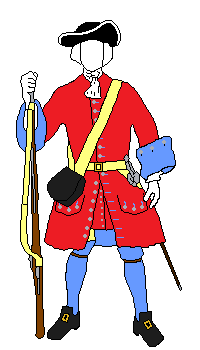
Biron 1701 |
Biron
Wenediger
von Braun |
1701-1705
1703
1706 |
According to Schorr Biron had in 1701 bleumerant facings and stockings, red
vests and white neckcloths. Venediger had in 1705 blue facings and stockings,
and black neckcloths.
According to Höglund, Biron had black facings and vests while Venediger had
blue facings and possibly blue stockings. I do not have any explanation
to why the information on Biron is different but Höglund also mentions
that the regiment's colours were coffee brown in 1706 ("dark coffee"
according to Schorr).
The button colour seems to be even more uncertain. Schorr notes pewter for Biron
but with brass in parenthesis, and a question mark for Venediger but
with pewter in parenthesis. Höglund has no information on the button
colour at all.
Existed 1699-1707.
Thorn 1703, Fraustadt 1706.
|
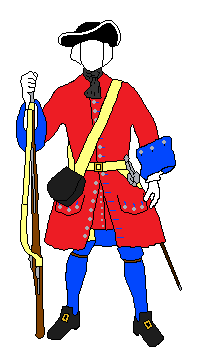
Venediger 1705 |
|
|
Höglund
states that Fürstenberg's regiment had dark blue cuffs and vest as well as
pewter buttons. Schorr mentions only dark blue cuffs and pewter buttons for
1701 but writes that in 1707 they had green cuffs and vest and white
neckcloth. A Danish source from 1715 states that the regiment's colour was
then blue.
Dark blue colours with silver decorations in 1701.
The regiment was raised in 1701. According to Höglund,
Fürstenberg was succeeded as colonel by Kaiser in 1706. But according to
Schorr it was Braun who succeeded Fürstenberg and this only happened in
1716. In the battle of Malplaquet a Saxon battalion was led by "Fürstenburg"
and also the Danish source from 1715 names the regiment as Fürsstenberg.
Posen 1704, Punitz 1704, Fraustadt
1706, in the Maritime Powers' service 1707-1713, Malplaquet 1709,
Tönning 1713, Stralsund 1715. |
|
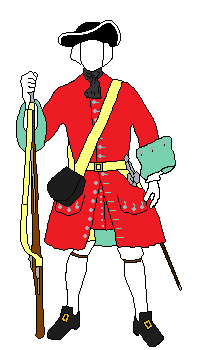
1701 |
Görtz
Sea green facings and pewter buttons. Höglund notes that the vest was sea
green while Schorr says it was red. Schorr also mentions that the neckcloth
was black.
Schorr writes that they had pewter buttons but also has brass buttons
in parenthesis.
Sea green colours in 1701.
Raised in 1701. Disbanded 1702 according
to Schorr, 1704 according to Höglund Kliszow 1702. |
|
|
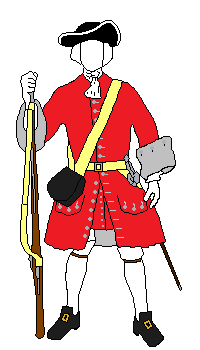
1701 |
Beichlingen (1701-1703)
Wackerbarth (1703-1714)
von Friesen (1714-) Grey facings. Höglund states they also had grey vests and brass buttons. Schorr
on the other hand have them with red vests and pewter buttons in 1701 and brass
buttons in 1707. Furthermore they had white leather breeches and
white neckcloths in 1701 and black neckcloths in 1707.
According to Höglund, it was decided in August
1706 that the regiment was to have green colours. These were exchanged
at an unknown time and in 1715 two of them were reused by von Friesen's
militia regiment ("green and red – with Polish coat of arms and name
cipher"). Raised in 1701. According to
Höglund, Wackerbarth was succeeded as colonel in 1717, but according to
Schorr it happened in 1714. |
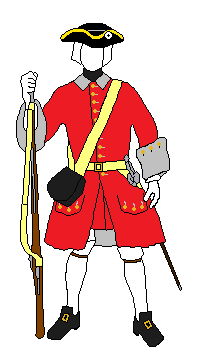
1707 |
Kliszow 1702, Posen 1704,
Punitz 1704, in the emperor's service August 1705 to January 1707,
a battalion in the Maritime Powers' service 1707-1713, Malplaquet 1709,
Tönning 1713, Stralsund
1715. |
|
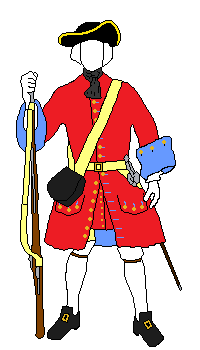
1701 |
Reuss
Bleumerant (pale blue) facings and brass buttons
(however, Schorr also has pewter buttons in parenthesis). According to Höglund
the vest was bleumerant and according to Schorr it was red. Schorr also states
that the neckcloth was black.
Light blue colours in 1701.
Raised in 1701. Thorn 1703, thereafter merged with Wostromirsky ("Wostromirsky
und Reuss"). Fraustadt 1706 and disappear after that from the
records. |
|
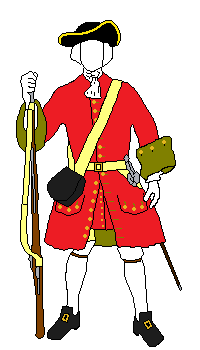
1701 |
Marschall von Bieberstein
Moss green facings and brass buttons. According to Höglund the vest was moss green
and according to Schorr it was red. Schorr also states that the neckcloth
was white.
In 1701 the colours were supposed to be moss
green, but it is uncertain if any were issued.
It is doubtful whether this regiment had completed its recruitment
before it was disbanded in 1702.
|
|
|
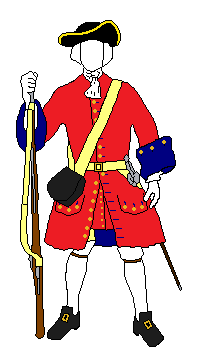
1701 |
Löwenhaupt
(1701)
von Reibnitz
(1701-1707)
Dark blue facings. Höglund states that the vest was dark blue while Schorr
writes that it was red. According to Höglund they had pewter buttons
while Schorr notes brass buttons with pewter in parenthesis. Schorr also mentions
that the neckcloth was white.
Dark blue colours in 1701.
Existed 1701-1707.
Thorn 1703, Merged with Drost 1705 ("von Drost und Reibnitz"),
Fraustadt 1706.
|
|
|
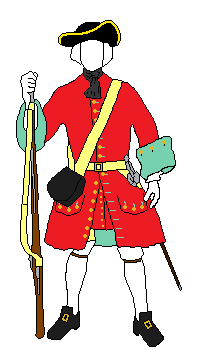
1701 |
Rothenburg
Sea green facings and brass buttons. Schorr adds that the vest was red
and the neckcloth was black. Furthermore, he has pewter buttons in
parenthesis.
Sea green colours in 1701.
It is doubtful whether this regiment had completed its recruitment
before it was disbanded in 1702.
|
|
|
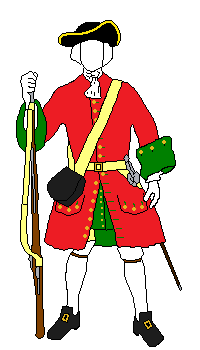
1701 |
Zeitz
(1701-1703)
Schulenburg
(1703-1705)
Green facings and brass buttons. Höglund also mentions that the vest was
green.
Unknown colour.
Existed 1701-1705.
Kliszow 1702 (?), Thorn 1703, Posen 1704, Punitz 1704.
|
|
|
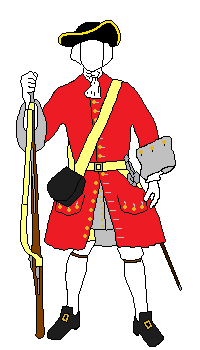
1701 |
Weimar
(1701-1703)
Kanitz
(1703-1705)
Grey facings and brass buttons. Höglund also mentions that the vest was
grey.
Unknown colour.
Existed 1701-1705. The men were transferred to the
Saxon Guard and Kurprinz. Höglund states that Kanitz was succeeded as
colonel by Bose already in 1703.
Thorn 1703, Posen 1704, Punitz 1704. |
|
|
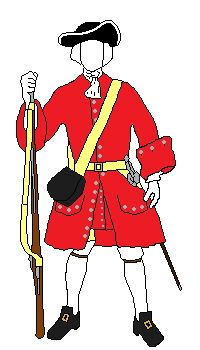
1701 |
Tromp
(1701-1703)
Drost
(1703-1707)
According to Höglund the facings and vest were pale blue and the buttons
were of brass.
Schorr writes that the facings and vest were red in 1701 (and that they
had pewter buttons
and white neckcloths). In 1703 the facings and stockings were grey, the vest red and
the neckcloth black. He notes brass buttons but with pewter in
parenthesis.
The colours consisted in 1706 of two dark grey and two crimson colours.
Existed 1701-1707.
Thorn 1703, Posen 1704, Punitz 1704, merged with Reibnitz 1705 ("von Drost und Reibnitz"),
Fraustadt 1706. |
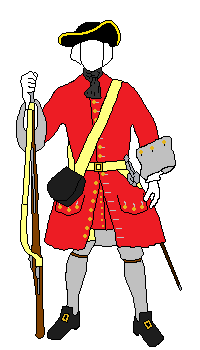
1703 |
|
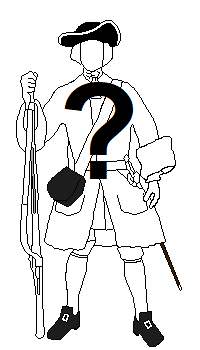
Flemming/Mannig/Seidlitz
Could be different names for at least two temporary (grenadier?)
battalions. No uniform details are known.
Kliszow 1702 (?)
Disbanded in 1702 |
|
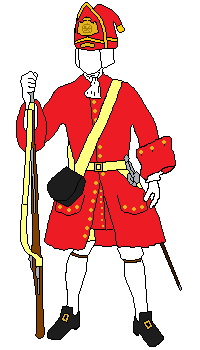
1701 |
Hayns grenadjärbataljon
(1701-1704)
Nehmitz grenadjärbataljon
(1704-1705)
According to Höglund the
uniform is unknown but Schorr states that the facings and vest were red,
buttons of brass and the neckcloth white. Schorr also writes that it is
unknown whether the battalion wore grenadier caps.
Existed 1701-1705. The men were transferred to the Saxon Guard. |
|
|
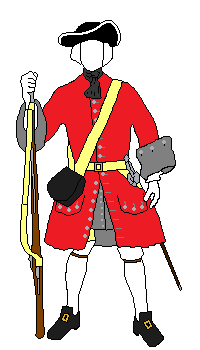
1701 |
Wostromirsky (1702-1707)
O´Gilvy (1707-1710)
Goltz (1710-1717)
Seissan (1717-)
According to Schorr the facings
and vest were in 1701 dark grey for the privates and black for officers.
The buttons were of pewter and the neckcloth was black. The officers had red breeches.
Both Schorr and Höglund
state
that in 1707 the facings and vest were bleumourant (pale blue) and
the buttons were of brass. Schorr also states that the neckcloth was white
Höglund mentions that the colours that had been issued in 1702 and 1706
were black. |
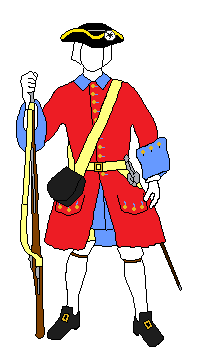
1707 |
Raised in 1702.
In the emperor's service November 1702 to May 1704, Posen 1704, Punitz
1704, Fraustadt 1706, a battalion in the Maritime Powers' service 1707-1713, Malplaquet
1709, Sandomir
1715. |
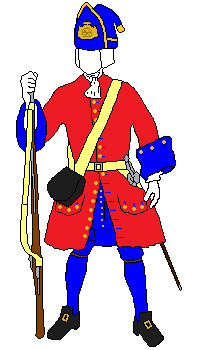
Martinières Grenadier Regiment
(Joyeuse's battalion at Fraustadt)
According to Höglund, the uniform is unknown, but Schorr writes that
the breeches and stockings were blue and guesses that the cuffs were
also blue. It is unknown if the regiment wore grenadier caps but Schorr
has a speculative illustration of the uniform with a cap that looks
like the one pictured here.
Raised in 1703 from French prisoners of war from the War of the Spanish
Succession. Lieutenant-Colonel Joyeuses' battalion was captured in the
Battle of Fraustadt, whereupon it went into Swedish service and
participated in the Battle of Kalisz.
Disbanded in 1706 and the men were transferred to Wackerbarth.
|

Malleraque
Raised in 1703 from Swiss prisoners of war from the War of the Spanish
Succession. Was captured at the Battle of Fraustadt in 1706 whereupon it
passed into Swedish service and participated in the Battle of Kalisz the
same year. Unknown uniform and colours.
|

Wolfenbüttel
Three companies raised in 1704, but the regiment
was probably never completed and was soon disbanded. Unknown uniform and colours. |
|
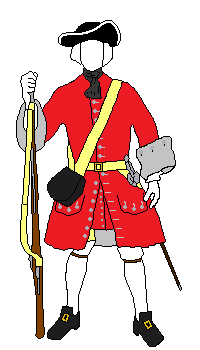
1704 |
Sachsen-Weissenfels
Grey facings and pewter buttons. According to Höglund the vest was grey and according to Schorr
it was
red and the neckcloth was black. The regimental colour was still grey in
1715 according to a Danish source.
Unknown colours.
Raised in 1704.
In the emperor's service August 1705 to January 1707. A battalion in
the Maritime Powers' service 1707-1713, Malplaquet 1709, Stralsund
1715, Stresow 1715.
|
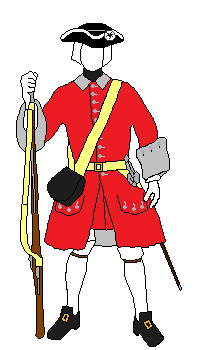
1715 |
|
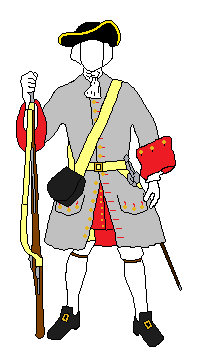
Seiffertitz
It was raised in 1705 with privates taken from the militia. These had according to Höglund light grey coats with red or blue facings. However, he thinks
that the regiment most likely was issued new uniforms that are unknown. Schorr
on the other hand writes that they had grey coats with red facings and
vests as well as pewter buttons and white neckcloths.
Unknown colours.
In the emperor's service August 1705 to January 1707.
Disbanded in 1707.
|
|
Ansbach-Bayreuth
(1709-1711)
Seckendorff
(1711-)
Raised in 1709 (as a grenadier
battalion?) and became an infantry regiment in 1711.
Blue facings and vest as well as brass buttons. Schorr also mentions
leather breaches.
One white and fourteen blue colours in 1714.
In the Maritime Powers' service 1707-1713, Stralsund
1715.
|
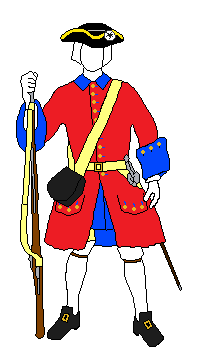
1710 |
|
|
 Seissan
(1711-1715) Seissan
(1711-1715)
Flemming (1715-1717)
Unknown uniform
and colours.
Existed 1711-1715. In the Maritime Powers'
service
1711-1713. Sandomir 1715.
|
 Seydlitz Seydlitz
Unknown uniform
and colours.
Existed 1711-1717
Sandomir 1715.
|
|
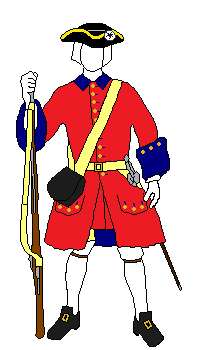
1711 |
Flemming
(1711-1715)
Wackerbarth
(1715-)
Raised in 1711 with men from the Dresdens garrison.
Brass buttons. Schorr states that they had dark blue facings in 1711 as
well as cinnamon facings and red vests in 1716. Höglund notes that they
had cinnamon facings and vests.
Unknown colours.
Sandomir 1715 |
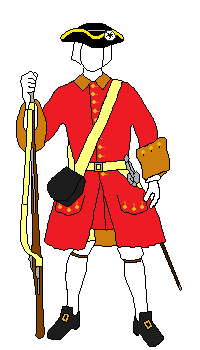
1716 |
|
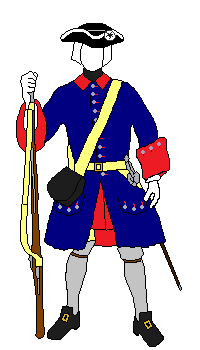
Ansbach-Kavanagh
Regiment from Ansbach in Saxon service 1713-
1717
The privates wore dark blue coat with facings, vest and lining in
crimson. Pewter buttons, leather breaches, grey stockings, black neckcloth and white
lace on the tricorne hat. The drummers wore crimson coat and breeches, white
facings, lining and lace along the sleeves. NCOs had silver edged cuffs
but were other than that dressed just like the privates. Officers had
crimson breeches, buttons and buttonholes in gold, white neckcloth and a
sash in silver and black.
Unknown colours.
Stralsund 1715, Stresow 1715.
|

Ansbach-Castelli
Regiment from Ansbach in Saxon service 1713-
1717
Schorr has no information about this regiment but Höglund mentions that
the coat was blue with pewter buttons and red facings. The vest was red,
the breeches were of leather and the stockings were light grey.
Unknown colours.
Stralsund 1715.
|
|

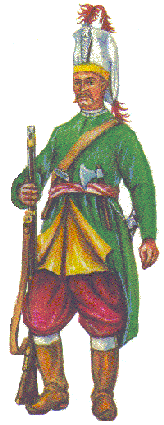 Dresden
Garrison Battalion Dresden
Garrison Battalion
Raised in 1701. Unknown uniform. Höglund writes
that it was possibly grey with red facings. Had a white colonel's colour
and a blue "Ordinärfahne" (no decorations has been described).
Janissary Corps
This corps was created either in 1715 or 1729 and it was disbanded in
1731. This was not a combat unit but rather a palace guard located in
Dresden. The uniform was in Turkish style and according to Höglund it
consisted of a yellow janissary cap, yellow coat, red vest, red breeches
and yellow boots. The officers wore a turban.
The image to the right show a different uniform and it is taken from
Reinhold Müller's book "Die Armee Augusts des Starken" from 1984. In the
text the coats are described as sea green "oberkleider" hanging all the
way to the ankles and worn over yellow "unterkleider".
|
|

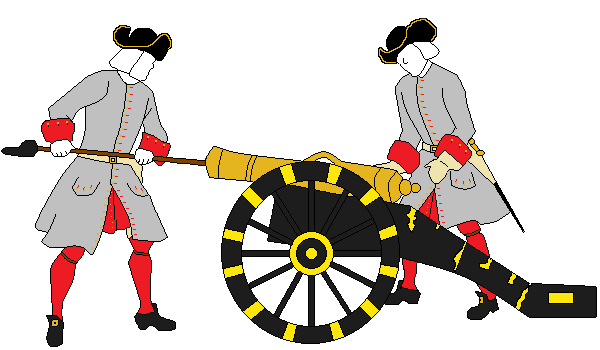
In 1700 they had black hats with yellow lace (gold yellow according to
Höglund). Grey coat with facings and lining in red as well as brass
buttons (Schorr states that the coat possibly had a collar). The vests
and stockings were red. According to Höglund the breeches were also red
but according to Schorr they were of leather. Schorr also mentions that
the officers had gold lace on their tricornes and a sash in red and
silver worn over the shoulder.
Höglund states that the uniform was changed in 1717 when the coat became
green with facings, lining and collar in red. The vest and breeches
became straw yellow and the stockings grey. The hat still had gold
yellow lace. However, Alexander Querengasser mentions in his article "The Saxon Army in the Great
Northern War" that the first companies received green coats as
early as
1700.
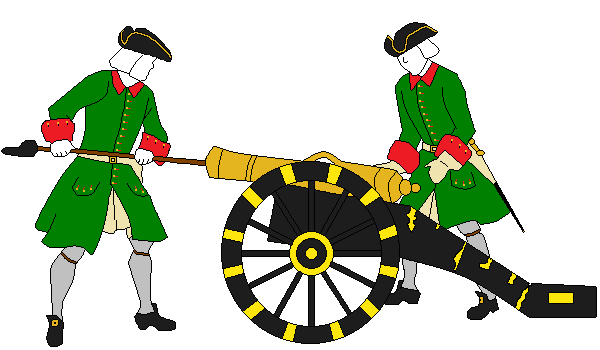
Carriages and wagons were painted black with the metal fittings painted
yellow.
|
|
References
Bellander, Erik.
Dräkt och uniform. Stockholm (1973)
Höglund, Lars-Eric – Sallnäs, Åke – Bespalov, Alexander. Stora
nordiska kriget 1700-1721, III. Karlstad (2004).
Müller, Reinhold. Die Armee August des Starken. Berlin (1984)
Qurengasser, Alexander. The Saxon Army in the Great Northern War.
(article in GNW-C). St. Louis (2015)
Schorr, Daniel. Notes
on the Saxon Army 1700-1716.
(2008) * GNW-C = Great Northern War Compendium with Steve Kling as editor.
* = an article published on the now defunct website
www.northernwars.com
"The Danish source from 1715" was conveyed
to me by Magnus Lindskog and a picture of it can be found at
this link. |

